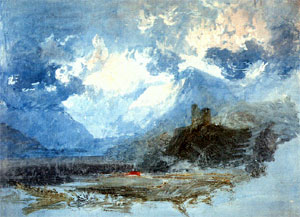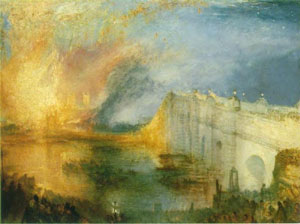 |
Pont de
Blois 1828 |
 |
| SCHUMANN (1810-56) - Arabesques in C. Op.18 |
| The life of English painter Joseph
Mallord William Turner, known as "the
painter of light", has been entirely devoted to his art.
Endowed with a robust and rough constitution, he was an insatiable traveller, untiringly moving around Europe, particularly in Italy, France, Germany and Switzerland. In any place, acting as a photojournalist, he made drawings or watercolors of all kinds of landscapes, sites and monuments. Thus at his death, he will bequeath to his country over 20 000 works on paper ! Whereas he had been at his beginnings a great admirer of Old Masters, especially French historical landscape painter Claude Gelée (1600-1682 named le Lorrain) and Nicolas Poussin, his work in a romantic style will evolve towards a new daring pictorial Pre-Impressionist representation, in which the artist dissolves details of painted subjects into colored atmospheres. |
He became well known and highly considered in his country and abroad by publishing his watercolor works, starting from 1826 in "The Keepsake" (one of these yearbooks combining literary and artistic matters, then very much appreciated by English society), and starting from 1831 in "The Turner's Annual Tour", a collection of steel or copper engravings.
However, the new style of his oil works, so extraordinarily modern for his time, was not understood by his contemporaries who would judge it "delirious". Nevertheless he kept unconditionnal admirers, John Ruskin being the first of them.
The life and work of Joseph Mallord William ![]()
![]() JMW TURNER, PRECOCIOUS AND
RECOGNIZED PAINTER
JMW TURNER, PRECOCIOUS AND
RECOGNIZED PAINTER
|
William Turner was born in London in 1775 from a modest family which he will always keep in his heart. His father, a barber and wig maker, shalll remain, until he died in 1829, his son's most faithful companion, while his mother gradually went insane and died in a mental hospital in 1804. From 1789 to 1793, Turner attended the courses of the Royal Academy, where he will study with landscapist Thomas Malton. At that time, Turner made numerous copies for wealthy art lovers, and met English landscape and watercolor painters such as Thomas Girtin. In 1792, he will start his studying journeys throughout England, Wales and Scotland, sketching or watercoloring landscapes and seascapes. Since he was 14, Turner got into the habit of wandering around countryside, with his sketch book, frequently walking over 40 kilometers a day . |
From 1796 on, Turner will regularly exhibit oil paintings at the annual exhibition of the Royal Academy, mostly historical subjects represented in fantastic and sublimated landscapes, in a way similar to that of 17th and 18th centuries' painters.
Very early Turner became successful and wealthy as a painter, and soon became recognized by artistical being elected as full academician at only the age of 27. Although he shall not refuse the duties of his academician statute, he will limit them, seeking from time to time for secret retreats, until his definitive withdrawal at the end of his life, when he totally disappeared under a false identity in Chelsea, a London suburbs on the Thames River.
Turner was described by Constable and Delacroix as slovenly in dress, with uncought manners, silent even taciturn, but with a wonderful range of mind. Entirely devoted to his art, Turner did not found a family. Whereas it is known that he has had several female companions throughout his life, especially Sarah Danby around 1798, whom he supported along with her children, and with whom he probably had his first natural child, his private life is not well known.
![]() TURNER, EUROPEAN TRAVELLER
TURNER, EUROPEAN TRAVELLER
The 1802 "Treaty of Amiens", which temporarily put an end to the Napoleonic war between France and England, allows Turner to go for the first time on the Continent to visit France, where he stays in Calais, Paris - where he studies the Old Masters at the Louvre Museum -, and in Savoy area. Then he moves to Switzerland in Piedmont area.
|
In 1804, Turner founds his own gallery to exhibit his works. In 1807, he paints his first views on the Thames River, taken from his own boat. The same year he gives perspective lessons at the Royal Academy School, and publishes the first part of his "Liber Studiorum" (1807-1819), including series of pen and wash drawings where he combines exact observation of nature with literary and mythological evocation. In parallel , during the 1807-1810 years, he gets interested in genre painting. |
Turner will always assiduously practice literature and poetry, which formed an important part of his inspiration, and will frequently quote Byron or Milton in the titles of his works.
![]() VENICE'S LIGHT
VENICE'S LIGHT
|
In 1819, Turner goes for the first time to Venice, a stay that is considered as a turning point in his work, in which representing light effects will become more and more important, to the detriment of the narrative aspect. ("San Giorgio Maggiore, Early Morning " - 1819). His oil paintings will use more brilliant colors, especially the warm colors of the spectrum (yellow, red). |
![]() JOURNEY IN THE LOIRE VALLEY, BEGINNINGS OF THE
"TURNER ANNUAL TOUR"
JOURNEY IN THE LOIRE VALLEY, BEGINNINGS OF THE
"TURNER ANNUAL TOUR"
In 1826, Turner went for a long journey in the Loire Valley, going upstream the Loire River from Nantes to Orléans.
|
He executed a great series of sketches and watercolors on more than forty towns and sites (an exhibition "Turner, the journey on the Loire River " took place in 1997-98, at both the Tate Gallery, Blois and Nantes). Twenty one of his views will be included in the 1831 first edition of his "Turner Annual Tour". Turner stilll remains the most important painter of the Loire landscapes, which will be celebrated at the same time by many French romantic writers such as Vigny, Balzac, Flaubert... He remarkably used the transparency of watercolors to suggest the delicacy of the light of the Loire Valley. This journey that Turner started in Calais will also be at the origin of several major oil paintings, such as "Pas-de-Calais", which he showed at the Royal Academy's annual exhibition of 1827. Because Turner has got into the habit of using more and more brilliant colors in his paintings, critics will then make fun of his excessive use of "yellow". |
![]() TURNER, PRE-IMPRESSIONIST
ROMANTIC PAINTER
TURNER, PRE-IMPRESSIONIST
ROMANTIC PAINTER
|
From 1829 until 1837, Turner's oil painting will change even more radically towards lesser interest in figurative description and always more focus and research on light effects representation. ("The Burning of the Houses of Parliament" - 1835). Thus, forty years before Monet, Turner invents a different way of painting which gets rid of all pictorial conventions to get its main interest in rendering atmospheres through colors. |
In 1833, Turner leaves for his second stay in Venice. He will return for the third and last time to Venice in 1840. Venice has inspired him many major paintings such as "The Grand Canal, Venice" - 1835 or "The Dogana, San Giorgio, Citella, from the Steps of the Europa" - 1842.
In 1837, he publishes "The Rivers of France", where his views of the Seine and Loire rivers have been brought together.
![]() TURNER DEFENDED BY RUSKIN
TURNER DEFENDED BY RUSKIN
|
In June of 1840, Turner met the young and rich John Ruskin (art critics and sociologist, 1819 - 1900), who became his most faithful and passionate defenser, as well a great collector of his works. In 1843, Ruskin will make a name for himself with his first volume of his Modern Painters where he eulogizes Turner's work. In 1844, Turner exhibits "Rain, Steam, and Speed, The Great Western Railway" at the Royal Academy, a painting whose modernity and construction will later draw interest from Impressionist painters. In 1845, he travels to France for the last time. |
![]() TURNER'S RETREAT IN CHELSEA
TURNER'S RETREAT IN CHELSEA
In 1846, Turner left his house in Queen Anne Street, built in 1812, ceased any contact with his relationships, changed his name and moved into a poor lodgment in Chelsea, on the other side of Westminster. There he will spend the last years of his life, in a complete loneliness, unreachable, not even recognized by his hostess.
In 1847, within Robert Vernon's bequest of contemporary paintings to the National Gallery, a first oil work of Turner enters English national collection.
In 1850, Turner exhibits at the Royal Academy 4 of his last paintings in the manner of Claude Lorrain.
![]() TURNER'S BEQUEST
TURNER'S BEQUEST
|
Turner died on december 19, 1851 at Chelsea, soon after he had been retrieved, and will be buried in Saint-Paul's Cathedral. He bequeathed his paintings collection to his country as well as a 200 000 livres sterling rent for building a house for poor artists. In 1857, an exhibition "The Art Treasures" will show 24 oil paintings and 83 watercolors by Turner. In 1857-58, Ruskin was allowed to select in Turner's bequest watercolors and drawings for a public exhibition at Marlborough House, where 400 of them will be framed. |
In 1861, only ten years after his death, a gallery in the West wing of the National Gallery will be entirely devoted to Turner's works.
| |
|
|









